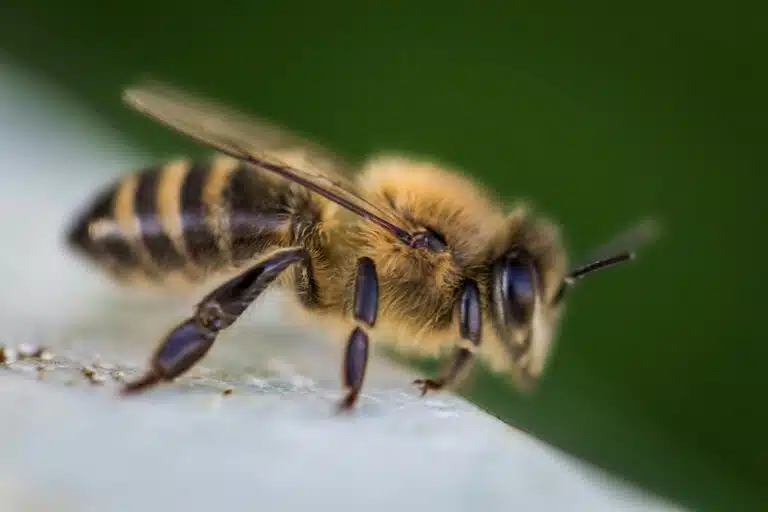BEE: Amazing Facts You Need to Know

Did you know that when a bee finds a promising food source, it passes on that information to the others when it returns to the hive through what is called the “waggle dance”?
Bees are winged insects, with over 20,000 known species in seven recognized families. Some species – including honey bees, bumblebees, and stingless bees – are social insects living in highly hierarchical colonies, while most species (above 90%) – including mason bees, carpenter bees, leafcutter bees, and sweat bees – are solitary.
Bees are fascinating insects with many interesting facts. For instance there are more than 20,000 distinct bee species around the world, with more than 4,000 in the U.S. alone. Also bees exist in all types of climates around the world, from forests in Europe to deserts in Africa, even in the Arctic Circle.
Here are some amazing facts, but not limited, that you should know:
FACT 1:
Approximately one third of the food we eat is the result of honey bee pollination. Honey bees are the only insect that produces food consumed by humans. Bees pollinate more than 150 commercial crops.
FACT 2:
Honey bees never sleep. They also have 170 odorant receptors and have a sense of smell 50 times more powerful than a dog. Also, honey bees’ antennae have more than 300 taste receptors.
FACT 3:
Bees have 2 stomachs – one for eating, and one for storing nectar and processing it into honey. Bees also have five eyes and honey bee brains are about the size of a sesame seed.
FACT 4:
Honey bees cannot see red light but can see ultraviolet light. This enables them to see intricate ultraviolet light patterns on flower petals that humans cannot see!
FACT 5:
Honey bee eggs hatch after three days and develop into larvae. When fully grown, the larvae transform into pupae. Queens become adults the fastest; they mature fully in just 16 days; workers take 21 days, and drones take the longest — 24 days.
FACT 6:
Worker bees are the smallest of the three types of honey bees, growing to just 10-15mm when mature. Drones are about 50% bigger, reaching 15-17mm as adults, and queens are the largest — almost twice the size of worker bees — 18-20mm at maturity. Worker bees live for about two to four weeks in the summer, but if they hatch late and are part of the hive that remains for the winter, they live for up to 11 months. These winter bees are called diutinus – a Latin word that means “long-lasting.”
FACT 7:
Honey bees beat their wings 11,400 times per minute. This is beating of wings makes the buzzing noise. A honey bee visits 50-100 flowers in one trip and can fly up to 15 miles per hour. Moreover honey bee worker only makes an average of 1/12 of a teaspoon in her lifetime.
FACT 8:
Drones live for four to eight weeks in the summer months and die soon after mating; they are never kept in the hive during the winter. Queens usually live for two to three years; some may for as many as five years. Worker bees have longer wings than drones; drones have bigger eyes than worker bees. Both worker bees and queens have stingers; drones are stingless.
FACT 9:
Honey is full of a variety of vitamins and essential minerals, antioxidants, and amino acids. Eating honey is a natural way to get an energy boost. It is a mixture of simple sugars glucose and fructose. Studies have shown that this works best in preventing fatigue and enhancing athletes performance. Also, honey is an antimicrobial agent and can be used effectively on minor burns or scrapes. It has been shown to speed the healing of wounds.
FACT 10:
Because of bees’ acute sense of smell, they can be trained to detect explosives, bombs, and landmines, as well as other chemicals of interest!
FACT 11:
Honey bees are generally not aggressive — they’ll only attack when the believe their hive is threatened. While bee venom is more deadly than cobra venom, it would take more than 3,800 bee stings to kill the average human male.
FACT 12:
Other than the queen, all bees defecate outside the hive. Honey bees work 24/7 to keep their hives clean, hauling out dust, hairs and pests. Honey bees are so obsessed with cleanliness that most will leave the hive when they know it’s time to die, to avoid contaminating brood and food stocks.
FACT 13:
One ounce of honey would fuel a bees flight around the world. A pound honey is made by 2 million flower visits. The bees fly 55,000 miles back and forth to bring that honey.
SOURCES: Maine | Best Bees | Wikipedia
#penglobalfactfile #bee


_1755775186.jpg)
